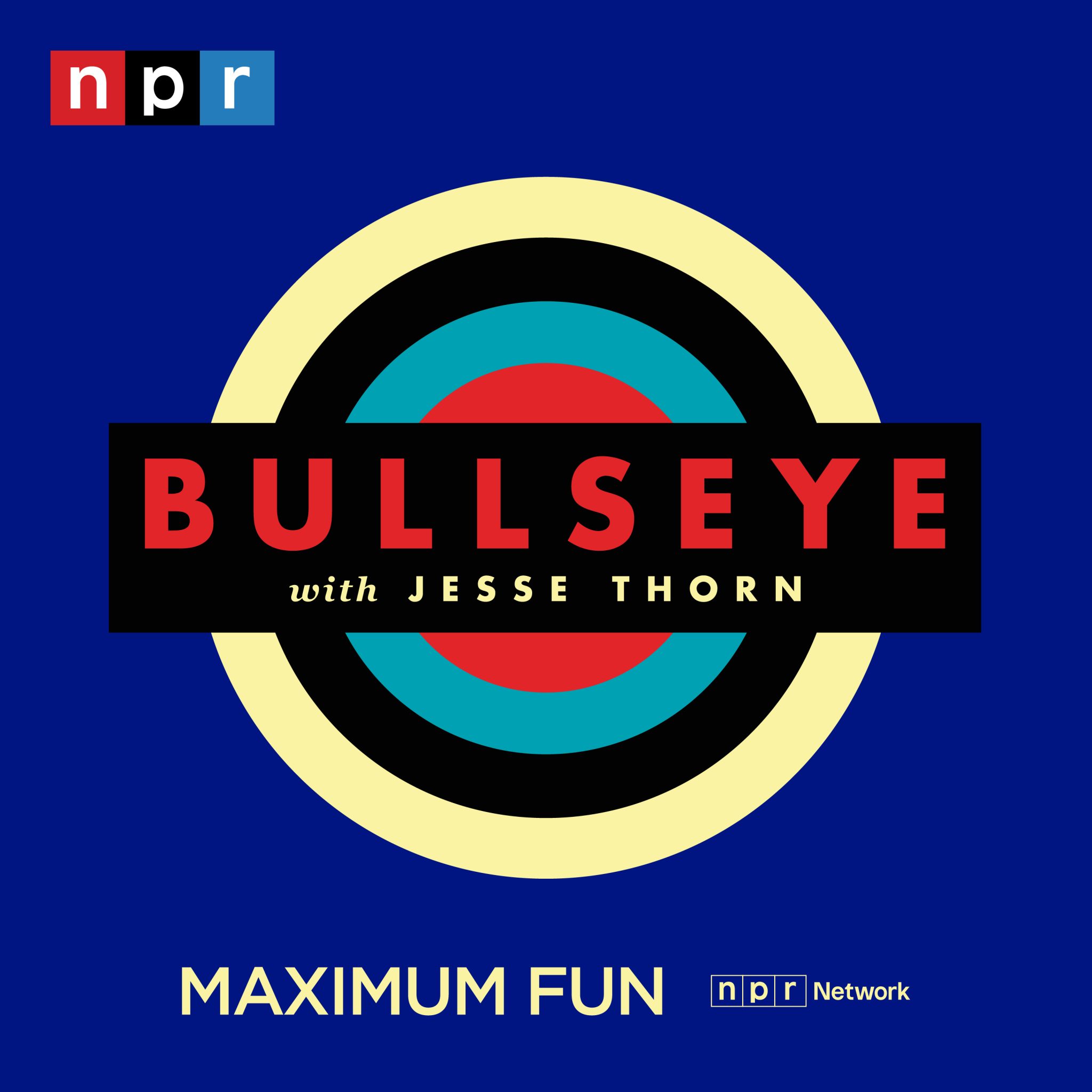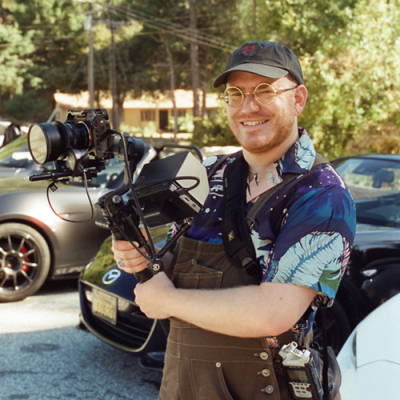Transcript
[00:00:00]
Transition: Gentle, trilling music with a steady drumbeat plays under the dialogue.
Promo: Bullseye with Jesse Thorn is a production of MaximumFun.org and is distributed by NPR.
Music: “Huddle Formation” from the album Thunder, Lightning, Strike by The Go! Team—a fast, upbeat, peppy song. Music plays as Jesse speaks, then fades out.
Jesse Thorn: It’s Bullseye. I’m Jesse Thorn. 90 years ago, Nancy was born. Just Nancy, no surname. She’s eight years old, about hip-high. She’s got a red skirt, black sweater vest, and a bow in her hair. You know the hair, right? It’s almost perfectly round, short, frizzy. She is a comics character. You could actually say she is, in a way, the comics character. Older than Peanuts, older than Beetle Bailey and Dennis the Menace. It’s also beloved by connoisseurs of the genre. You don’t have to be a superfan to love it, of course. It is one of the most broadly successful newspaper comic strips ever. But it’s also a snob’s favorite. Like, if the Velvet Underground did Green Day numbers. Why? Well, the aesthetic is iconic in that everyone would recognize it. And also, in that it is made of icons: the simplest forms that represent something much more complex. That’s what comics are, after all.
And instead of being about old, familiar characters like a lot of strips, the jokes in Nancy have a surreal, almost abstract quality. The punchline is as often about the comic’s form as it is about kids causing trouble. One of those comics super nerds, who loves Nancy, Bill Griffith. Griffith is a newspaper comics artist himself. He’s written Zippy the Pinhead for 50 years. He got turned on to the magic of Nancy decades ago by a fellow alternative comics luminary, Art Spiegelman. Griffith’s new book is a graphic biography of Nancy’s creator. It’s called Three Rocks: The Story of Ernie Bushmiller. I’m so grateful to get to talk to Bill about his wonderful book. Let’s get right into it.
Transition: Cheerful, chiming synth.
Jesse Thorn: Bill Griffith, welcome to Bullseye. I’m so thrilled to have you on the show.
Bill Griffith: I’m very glad to be here.
Jesse Thorn: What’s on your bolo tie there?
Bill Griffith: The symbol for the atom. I collect bolo ties. My category is $9.99 and under.
Jesse Thorn: (Laughs.) I noticed that there’s more bolo tie material than you would expect in Three Rocks, especially given that Ernie Bushmiller did not wear bolo ties. Only you wear bolo ties. And your contempt for southwestern-themed bolo ties really shone through—which is the main category of bolo ties!
Bill Griffith: Yeah, I know. Well, when I was about 14, my grandfather gave me a bolo tie. And he was living in Denver at the time, so he thought of himself as a westerner. And I remember wanting to like it, but somehow the—even then, decades ago, the Indian motif seemed kind of phony to me, like appropriating Indian imagery or something. It just didn’t seem right. So, when I finally discovered the novelty category of bolo ties, then I was happy. And I have a fairly large collection of those.
Jesse Thorn: What was your relationship with Nancy, the comic strip, before you started working on this book?
Bill Griffith: Well, it goes back to my learning to read as a kid growing up in Brooklyn. I remember what attracted me to the Nancy Sunday strip. It wasn’t the drawing. It wasn’t Nancy or Sluggo. It was the lettering. Bushmiller’s lettering was large, and it contained no punctuation marks. So, it was easy for a five-year-old learning to read—easier to read Nancy than any other comic strip in the Sunday funnies. So, I was just drawn to it. You know, that was my gateway drug into Nancy.
Then I began to get into, I think, more Sluggo than Nancy as a kid—for the same reason everybody does. Once you’ve begun to read a Nancy strip, you’re in it whether you like it or not. It pulls you in by its sheer iconic power.
Jesse Thorn: I mean, that is the thing that I thought of as you described being a kid looking at Nancy. Which is, to some extent, the subject matter of Nancy is kid friendly or kid appropriate or kid understandable.
[00:05:00]
But the aesthetic of Nancy is so clear that—I mean, it’s like that’s part of the business of cartooning, but it is like at its greatest apotheosis in Nancy. It is such a clear thing to look at.
Bill Griffith: Yeah. Nancy looks like the result of a How to Draw a Cartoon correspondence course. The characters look like—they look generic, and in many ways they are. But the thing you have to remember about Nancy strips is that they’re not about childhood. They are about jokes. They are about telling punchlines, but what they’re really about is the nature of comics themselves—how comics are read and what they can do.
Bushmiller, without realizing it, was dealing with the building blocks of what comics are. Narrative flow, sight gags, things that only can really happen within the confines of a four-panel comic strip. Other comics are trying to replicate real life. Nancy is just trying to be pure comics.
Jesse Thorn: I was struck when I saw the illustrations that Ernie Bushmiller made early in his career, in that they sort of reflected the legacy of the aesthetics of comic strips from the earliest part of the 20th century. Which, you know, could be really beautiful, were a lot more complex, maybe? A lot denser?
Bill Griffith: Yeah. Well, see, Ernie started doing comics when he was about 17. He dropped out of high school. He got a job with a daily newspaper in New York, and he worked his way up after a few years into the comics part of the newspaper. So, he learned how to draw on the job. But early on, when he was about 19, he realized he needed more—I don’t know—training in just the art of drawing. So, he surreptitiously took a couple of years of classes at an art school in New York City. Not a college, but just a place where you would go to draw from live models. And during that time, he became quite good at the kind of drawing that you’re talking about—the kind of nice, illustration-y, representational drawing.
But when it came to Nancy, for some reason that all went out the window. I think it was partly the stress of doing the strip every day that led him to try to simplify things. That part of his development is still somewhat of a mystery to me, how he went from kind of a nice illustration style to this super iconic, you know, almost rubber-stamp style of comic art. I’m glad he did, because he would have been just one more person doing a nice drawing in comics. In doing Nancy the way he did, he stood out from everybody else.
Jesse Thorn: More still to come with Bill Griffith. Stay with us, it’s Bullseye from MaximumFun.org and NPR.
Transition: Playful synth with a syncopated beat.
Jesse Thorn: Welcome back to Bullseye. I’m Jesse Thorn. My guest is Bill Griffith. Bill is the author of the new graphic biography Three Rocks: The Story of Ernie Bushmiller. Bushmiller created the legendary comic strip Nancy in 1933. It’s one of the most influential strips ever and still very funny even today. Nancy has inspired the work of countless comics artists, including Griffith—my guest. He’s the creator of the daily strip Zippy the Pinhead, which has been running since 1971. Let’s get into the rest of our conversation.
Nancy has been running on and off in newspapers for the full length of the lives of basically every single person listening to this right now. But I’m sure there are people who are listening who only have the vaguest memories of what Nancy even is. If you met somebody at a party and said, “I’m working on a book about Nancy,” and they said, “Nancy, which one is that?” How would you describe it?
Bill Griffith: Well, I teach comics at the School of Visual Arts College in New York. So, my students are all 19 years old. They’re all sophomores. And I give them a sort of—a couple of classes in Bushmiller. I show them my book, and I have them read it, and we talk about it, and I have them do Nancy strips.
[00:10:00]
Before we start I ask them, “Has anybody ever heard of Nancy the comic strip?” And I get no response. But then when I put up a big face of Nancy with her spiky black hair, they say, “Oh, that Nancy.”
And then I say, “Well, how do you know about Nancy?”
And they said, “Oh, we have the t-shirt.” (Chuckles.)
So, Nancy has worked her way into the visual databanks of almost everybody somehow. I don’t know, you know, how that happened. But the way to get into Nancy, to people who haven’t read it or heard about it or just vaguely know about it, is to talk about how it looks. And specifically, Nancy’s beautiful, black hairdo that—there’s no other strip that has hair like that. She’s totally on her own with her look.
Jesse Thorn: She has like little black hole eyes, a little flared skirt, and her hair—as you said—is like the most famous thing about her. It is sort of round around her head and has a big red bow on it and ends in these little spikes.
Bill Griffith: It’s a helmet. It’s a black helmet that comes down on the forehead. And it’s basically round, but not quite. And it contains evenly spaced little spikes coming out of it. Ernie had assistants that helped him do Nancy after it became really popular and the workload was too much. He hired a couple of people to work on Nancy with him, and he specified at different sizes that his assistants would draw Nancy how many spikes were to be shown in her hairdo. The one that was the most common was 69 spikes, and he insisted that his assistants count them to be absolutely precise, so that it looked just right. And if they didn’t get it right, he had them do it over again.
Jesse Thorn: He, in fact, specified the type of nib they should use on a pen, specifically to draw those little wisps of hair.
Bill Griffith: He said to use a fountain pen, the end of which had been cut so that it was blunt instead of a round end, and then to draw the spikes at a slight angle from Nancy’s helmet hairdo. Yep.
Jesse Thorn: I think the thing that baffled me most as a child, looking at Nancy in a newspaper was that—you know, she has her friend Sluggo, who she interacts with a lot. Sluggo is sort of like a boy version of her, aesthetically. And then she lives with her aunt, who looks as though she came from a completely different world.
Bill Griffith: Absolutely. Yeah, Nancy lives with her aunt, Fritzi Ritz. So, the reason that happened is because Ernie Bushmiller took over the Fritzi Ritz comic strip in—I believe it was late ’20s, early ’30s. The Fritzi Ritz comic strip was about a kind of an independent flapper kind of female named Fritzi who went through a series of boyfriends, all of whom she dumped one after the other and had lots of adventures and was kind of a pinup in her appearance. You know, wore fashionable, slightly sexy clothing.
So, Ernie was given the job of taking over that strip, and after a few years of it, he thought, “This is a bit dated. I’m gonna have to modernize this. What should I do?” And he thought, “Maybe I’ll add a kid into the strip who would shake up things, who’d be kind of annoying to Fritzi.” So, he created Nancy in 1938, and Nancy just appeared all of a sudden. And within six months, that’s all anybody wanted to read. They wanted to read about Nancy. So, Fritzi came into the strip through her original incarnation as a separate character. So, when you say she looks like she came from another strip, she did.
But Ernie was told by the people running the paper he was working for that he couldn’t get rid of Fritzi, because Fritzi represented sex. And therefore, Nancy had the perfect kind of demographic audience: men who thought they could get some sort of thrill out of looking at Fritzi and her sexy poses and kids who would read Nancy and think of Fritzi as kind of the authoritarian aunt who they wanted Nancy to control.
[00:15:00]
Jesse Thorn: I mean, Nancy lives in a world that is so simple and abstract that the only thing that really matters in each strip is like one idea of a joke. And it’s not even usually like a character joke. Like, the kids are impish. Like, they have some character qualities, but like mostly she just lives in a joke, you know? (Chuckles.) And Fritzi feels like she came in from Prince Valiant or something, where it’s driven by narrative and complicated background drawings, you know?
Bill Griffith: Right. Yeah, Fritzi wants to act maternally towards Nancy in a disciplinarian kind of a way, which gives her a personality. Nancy and Sluggo and the other characters are more stand-ins. They’re almost like these two-dimensional cutouts that live in the world in which everything is very reduced and iconic. Like, the reason I called the book Three Rocks is because that’s one of the standard kind of backgrounds that you see. When Nancy and Sluggo are walking down a sidewalk, behind them is—you know—one tree, one house, and three rocks, perfectly hemispheric and shaded. The purpose of a Nancy strip is to tell you a sight gag as quickly as possible, usually four panels.
Ernie worked backwards. He thought of what he called the snapper—the joke, the punchline. He thought of that first, then he said to himself, “Okay, now how do I get there?”
Jesse Thorn: When you were swimming in the world of underground comics in the late 1960s, did you talk to your comics pals about Nancy?
Bill Griffith: I was reintroduced to Nancy, having been kind of a fan at the age of five or six, by Art Spiegelman in 1970 in San Francisco where we were both working in underground comics. He was kind of my education in many ways as to the history of comics. He had a lot of books I didn’t have. He had just all kinds of knowledge. He had one book that was printed in the late ’40s that gave brief biographies of all the famous newspaper cartoonists of that era. And I remember reading the one about Ernie Bushmiller, which included a couple of drawings about Nancy. And I thought, oh, that was a great strip. And then Art and I would just talk about Nancy and talk about how surreal it was, and how strange it was, and how powerful it was.
Jesse Thorn: There’s this series of pages in Scott McCloud’s Understanding Comics, which is like a sort of textbook of the interpretation of comics as a form. And they’re about the way that we relate to characters as they become progressively more abstract. And McCloud is kind of arguing—and this is from memory, so apologies to Scott McCloud if I’m mischaracterizing anything. But you know, he kind of argues that as the character becomes more abstract in its depiction—more iconic in its depiction, I should say—it becomes more relatable, because we can imagine ourselves within those simple lines.
(Chuckling.) Nancy feels almost like a joke about that. You know? Like, it’s as though Bushmiller figured that out and was like, “I see your five and raise you ten.”
Bill Griffith: Nancy is not inviting you into her world. Nancy is just saying, “Come to my world and get the joke that I’m telling you and then leave.” You know? Nancy doesn’t care if you like her. Sluggo could care less if you like him. They just want you to stay long enough to get the joke and then leave and then come back the next day for the same thing.
Jesse Thorn: We’re gonna take a quick break. When we return, I will talk with Bill Griffith about his day job. He’s the creator of the wonderful Zippy the Pinhead comic strip, which has been running in newspapers for over five decades. Keep it locked. It’s Bullseye from MaximumFun.org and NPR.
Transition: Playful, chiming synth.
Jesse Thorn: I’m Jesse Thorn. This is Bullseye. I’m talking with cartoonist and writer Bill Griffith.
[00:20:00]
He created the long-running strip Zippy the Pinhead. He’s also the author of the new graphic biography Three Rocks: The Story of Ernie Bushmiller, The Man Who Created Nancy. Your very, very long running comic strip, Zippy the Pinhead, and other works that grew out of the underground comics world where you got your start were often about pushing the limits of what comics were and could be in various directions. And I wonder if part of the excitement of Nancy to you is that it is undertaking the opposite job—which is rather than expanding comics, refining comics to the absolute sharpest, narrowest point.
Bill Griffith: Yeah, I’m jealous of Ernie and his formulaic approach to comics. If it didn’t have that surreal charge though, it wouldn’t work. You know? There are plenty of comics during the period when Nancy was flourishing that were simply drawn. There was a certain cartoon style in which Nancy does sort of fit, but with none of Nancy’s intensity. There’s something that is incredibly intense about looking at a Nancy panel that doesn’t happen when you look at some similar cartoony-looking strip from the same era, whose purpose was really just to, you know, continue in a kind of tradition.
Ernie took the simple cartoon tradition and made it completely his own. Most cartoony comics during his time period wanted to get you involved in, you know, the cuteness, usually. The cuteness of the character or the way you would think “oh, I was like that when I was a kid” kind of feeling. And Ernie never had that interest. He simply wanted you to say, “Wow, that was funny. I’ll come back tomorrow for more.”
Jesse Thorn: Do you think of being funny as a or the goal of your work with Zippy?
Bill Griffith: Oh, yeah, sure. The most satisfying response I get—and of course, these days it’s all through email—is that someone laughed. Someone said, “You really made me laugh with today’s Zippy.” That gives me the best feeling. My delivery of that laugh may be somewhat indirect. So, when someone does laugh at a Zippy strip, that means they understood, or they felt, or they were happy with the path that took them to that laugh. But yes, my purpose with my Zippy strip is to make people laugh with an unconventional approach to joke telling. I don’t do what Ernie did. I don’t usually deliver a punchline in the last panel.
So, when someone laughs at one of my Zippy strips, they might be laughing at something Zippy said in panel number two. And by panel number four, it was just a way of the strip kind of ending. But the real joke, the funny moment happened in panel number two. But I’m aware that I have a cult audience and Zippy is not for everybody. But I am—for those people, I am delivering laughter. That’s what I’m trying to do.
Jesse Thorn: I’m such a Zippy fan myself, and it was one of my father’s favorite things, you know. He used to cut them out and put them on the wall in his office. You know, the way that people do with New Yorker cartoons that they identify with. Do you know what I mean? And one of the things about Zippy is, as you said—like, the funny moment could come anywhere. And the funny moment often isn’t a joke. The humor is more about just an unusual way of engaging with and imagining the universe. You know what I mean?
Bill Griffith: Yeah. Zippy is about wordplay. Zippy is about language. So, Zippy jokes, Zippy humor isn’t about the traditional kind of punchline humor. It’s whether or not you laugh at Zippy’s juxtaposition of three images in one word balloon.
[00:25:00]
A lot of times people will tell me, “You know, when I first read Zippy, I didn’t get it. I didn’t particularly like it. But you know, there it was on the newspaper page.” These are the days when people are reading newspapers. “And so, I kind of read it without getting it. Six months into that process, a light bulb went off over my head, and suddenly I got Zippy.” And they don’t necessarily describe the strip that did that, but what they’re telling me is it took them that long to get onto Zippy’s wavelength, but once they arrived there, they wanted to keep on that wavelength. They were enjoying it, but it was not easily obtainable.
Jesse Thorn: How many newspapers does Zippy run in?
Bill Griffith: Little over 100, down from 200 or 300. You know, newspapers are slowly dying, although I’m happily aware that it’s happening in slow motion. I remember 15 years ago, I was talking to Brian Walker, who does Hi and Lois and, you know, takes up the pen of his father, Mort Walker, to do Beetle Bailey. And we were talking about the slow shriveling of newspapers. And he said, “Yeah, it’s happening, but it’s in slow motion.” And I thought I hope so! And he was right.
Jesse Thorn: When you think about Zippy being in over 100 newspapers or hundreds of newspapers, are you ever surprised that this page in the newspaper that has Hi and Lois on it also has something as genuinely strange as Zippy?
Bill Griffith: I am just as surprised as a reader who may stumble upon seeing Zippy right next to The Family Circus. I remember another cartoonist friend of mine, Justin Green, once told me that when he looked at Zippy on the pages of the San Francisco Examiner, he saw a gaudy sailboat piloting its way against the current. That’s what he said. The other strips were all going in the same direction, down the mainstream, and Zippy was paddling up the other way.
So, I don’t know. I don’t have nearly the success that Ernie Bushmiller had, but I’m happy. I consider myself extremely lucky to have had a career out of doing something as unconventional as Zippy the Pinhead.
Jesse Thorn: Well, Bill Griffith, I sure am appreciative of your time and your work. Thank you so much for talking to me.
Bill Griffith: I was happy to do it.
Jesse Thorn: Bill Griffith. His book, Three Rocks: The Story of Ernie Bushmiller, The Man Who Created Nancy, is a beautiful appreciation of Bushmiller’s work. If you’d like to check out Griffith’s strip, Zippy the Pinhead, we’ll have a link to it on our website at MaximumFun.org. Or you can just open up the newspaper and look at the comics page, if you got a good newspaper.
Transition: Cheerful, funky synth.
Jesse Thorn: That’s the end of another episode of Bullseye. Bullseye, created from the homes of me and the staff of Maximum Fun, in and around greater Los Angeles, California. Here at my house, my new dog, Junior, just ate a cancelled check.
Our show is produced by speaking into microphones. Our senior producer is Kevin Ferguson. Our producers are Jesus Ambrosio and Richard Robey. Our production fellow at Maximum Fun is Daniel Huecias. We get booking help from Mara Davis. Special thanks this week to Ryan McEvoy at the Yale Broadcast Studio for recording our interview with Bill Griffith. Our interstitial music is by DJW, also known as Dan Wally. Our theme song is “Huddle Formation” by The Go! Team. Thanks to The Go! Team. Thanks to their label, Memphis Industries.
Bullseye is on Instagram @BullseyeWithJesseThorn. We hope you will follow us there. And I think that’s about it. Just remember, all great radio hosts have a signature signoff.
Promo: Bullseye with Jesse Thorn is a production of MaximumFun.org and is distributed by NPR.
(Music fades out.)
About the show
Bullseye is a celebration of the best of arts and culture in public radio form. Host Jesse Thorn sifts the wheat from the chaff to bring you in-depth interviews with the most revered and revolutionary minds in our culture.
Bullseye has been featured in Time, The New York Times, GQ and McSweeney’s, which called it “the kind of show people listen to in a more perfect world.” Since April 2013, the show has been distributed by NPR.
If you would like to pitch a guest for Bullseye, please CLICK HERE. You can also follow Bullseye on Twitter, YouTube, and Facebook. For more about Bullseye and to see a list of stations that carry it, please click here.
Get in touch with the show
People
How to listen
Stream or download episodes directly from our website, or listen via your favorite podcatcher!






